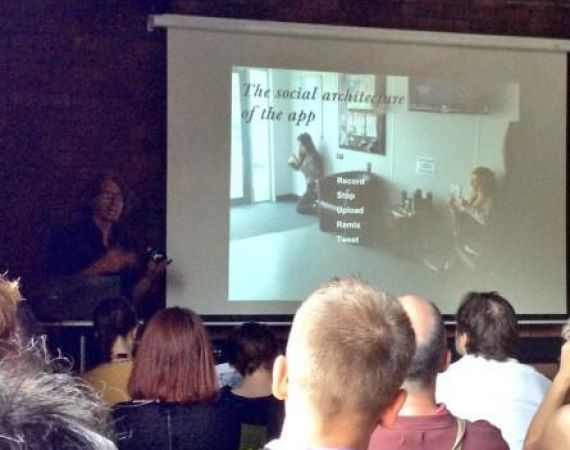Posted on Fri 20 Jun 2014
Nth Camera Lunchtime Talk Write-up
On 6 June, Studio residents Tim Kindberg, Charlotte Crofts and Mandy Rose gave a talk about their brilliant new REACT funded project Nth Camera, which aims to democratise and popularise multi-viewpoint, multi-screen video. Tim introduced us to the software, and gave us a live demo, and then Mandy…

Image @theflyingeditor
On 6 June, Studio residents Tim Kindberg, Charlotte Crofts and Mandy Rose gave a talk about their brilliant new REACT funded project Nth Camera, which aims to democratise and popularise multi-viewpoint, multi-screen video. Tim introduced us to the software, and gave us a live demo, and then Mandy and Charlotte introduced us to some of their research surrounding Nth Camera’s cultural context and the social architecture it establishes.
The concept of Nth Camera developed out of Nth Screen, a project that Tim has been working on for a couple of years, involving the creation of software to enable synchronised film viewing across multiple devices. A good example of an Nth Screen film, which demonstrates the creative potential of the software, is Studio resident Hazel Grian’s ‘Nth Bird’. The film can only be viewed properly when a number of people with smartphones/tablets stand in a circle. When one person presses play, every screen shows different shots of trees, making up one synchronised, multi-screen film. Sporadic birdsong is heard coming from the different devices, and as the film progresses, you start to see birds flying from one screen to another.
Tim has just been awarded a second lot of REACT funding for Nth Camera, which allows people to synchronise filming across multiple devices. He showed us a few videos that emerged from Nth Camera workshops, including a video collage of RIFE journalist, Jon, a collection of Studio Residents and Producers using their phones as mirrors, and a film of people’s walking feet from a workshop at KWMC. Tim told us, and it was clear from the films that filming in a group can be a lot of fun.
Although Nth Camera films were initially conceived to be viewed in Nth Screen playback on the devices used to film them, the feedback that the team have had so far indicates that most people prefer to view their Nth Camera films in a web montage, where you can see each piece of footage side by side, and ‘sculpt’ the different pieces of footage into a multi-screen composition. This kind of dynamic multi-viewpoint multiscreen is very pleasing to watch, especially when you can see connections between the footage, like someone walking from screen to screen in the background, adding to the fabric of the film.
Tim then asked for a few volunteers to make a quick Nth Camera film as he spoke. Tim then opened a collage of the films on a web page. There was a slight delay to the sound, and Tim said that at beta stage there will be an option to chose which video emits sound on playback, so you are only hearing the sound recorded on one device (unless you like the delay, he showed us an Nth Camera film of ping pong where the delay had a lovely crackling quality to it.)
Something that the Nth Camera team are fascinated by is the social architecture of the app, this multi-user mechanic throws up some interesting questions about group dynamic and when filming in a group. Should all involved be able to press record, stop and share? Should there be a ‘director’ among the group, who is able to choose when the film begins and ends? Should the film only be shared when everyone presses ‘share’? Tim and Charlotte said these are questions that all need exploring. Charlotte said she is also very interested in the kind of ‘physical editing’ you see when people are getting themselves into different positions to film different angles before pressing ‘record’ before an Nth Camera film.
Mandy said that although we are used to linear, single point-of-view films, multiscreen has always been lurking in the background, occasionally being explored by pioneers of film, such as Ferguson and Kroitor, before creating the IMAX. As we live in an era of low cost, accessible tools for film-making and free online distribution, the time is ripe for a project like Nth Camera, which allows for multi-user, as well as multi-screen content.
There is lots of potential for this sort of multi-user filming, in a creative sense, as a way of capturing moments like a graduation or wedding, and also as a means of authentication; a witness tool to help avoid the ‘Rashomon Effect’ (conflicting witness accounts) in demonstration situations for example.
Nth Camera has been used to make Laura Kriefman’s Kicking the Mic trailer, and will be used to film HighWaterLine Bristol in July. If you are interested in using Nth Camera yourself, have a look at the website and contact Tim